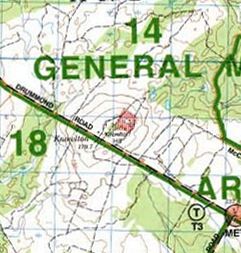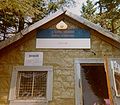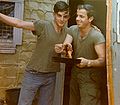Knowlton Hill
The RRB service was initially provided using a radio vehicle and then later from a cabin that was built at the site. Eventually, on 8 March 1973, a new unmanned automatic rebroadcast facility located in Petersville and leased from NB Tel was activated thereby eliminating the need for the service at the RRB cabin.
On the 20th of June 1973 the location of the RRB station was officially dedicated as Knowlton Hill (it was previously known as Drummond Hill) and a stone marker was unveiled. Present at the dedication was Col John Knowlton and Major John Dicker, the former and current Commanding Officers of 3 Signal Squadron.
Eventually the RRB cabin became in such disrepair, that in the spring of 1988 it was decided to destroy it. In April 1988, 22 Field Squadron demolished the shack. Capt Nicolas (then OC Combat Training Centre Signal Troop) proposed building a new log cabin in its place. The building of the log cabin was a self-help project taken on by Combat Training Centre Signal Troop, 724 Communication Squadron and the 2 RCR Signal Platoon, with occasional help from other CFB/CTC Signalers.
The new log cabin, which took almost two years to complete, was officially opened with a dedication ceremony on 21 October 1989. Col (ret) John Knowlton was the official “Guest of Honour” and dedicated the Log Cabin to be named ‘SIGNAL INN’.
Unfortunately, three weeks after the new Log Cabin opened, it burned to the ground in an accidental fire caused by a lit BBQ.
At some point in time (by 2002), the stone marker was removed from Knowlton Hill and moved to a location outside Building D5 (), CFB Gagetown, the HQ of then 3 Area Support Group Signal Squadron.
Contents
The Gagetown Gazette - 8 July 1971
The following article on the RRB site is from the 8 July 1971 issue of The Gagetown Gazette:
The Range Safety Net is a Very High Frequency radio net, and one of the characteristics of VHF radio working is that the radio wave travels a line of sight page, thus to communicate to all parts of the training area a rebroadcast facility is required. This station receives the radio signal and automatically retransmitts [sic] them.
The station was originally manned as requested by the various units in the base, but with the coming of the Combat Arms School in 1970 it is now operated on an around the clock basis for the entire year.
Manning the rebroadcast site requires a continuous commitment of five radio operators and frequent trips by the radio and vehicle technician to service the radios and the power generator. The round trip is a 35 mile journey and at time during the winter months becomes most exciting.
Although the station is isolated no lack of volunteers has been encountered due to the excellent fishing and hunting in the area.
Fresh rations are drawn from base and cooking is done on a wood stove, which also doubles as a heater during the winter months.
Power for both radio and lights is supplied by a generator at the site.
Protection against bears and porcupines is provided by 'Sam' a dog of unknown parentage and the official mascot of Communications Troop.
It is hoped that in the near future an automatic system will be installed which will provide automatic rebroadcast facilities between mobile stations in the training area and the central control stations at Base Gagetown. To add flexibility to the system, selected mobile stations in the area will be able to go through the rebroadcast system and work into the Base switchboard.Tower Times Artcle - 19 July 1973
The following article on Knowlton Hill is from the Thursday 19 July 1973 edition of The Tower Times, the CFB Kingston newspaper of the day. The article is entitled "Hill Named After Commander" and reads as follows:
The former site of 3 Signal Squadron's Range Safety Rebroadcast Station C/S 44 was named in honour of Col. J. G. B. Knowlton, a former Commanding Officer of 3 Signal Squadron who is now Commander of CFB Kingston, the traditional home of military communication personnel. Col. Knowlton was the last Chief of Communications Mobile Command, and serves in many capacities as a Signal Officer, including Commandant at the Royal Canadian School of Signals.
The commemoration and site naming ceremonies officially marked the close of a vigil that 3 Signal Squadron personnel maintained in support of the Combat Training Centre. For over two years, C/S 44 provided rebroadcast facilities twenty-four hours a day, seven days a week, first from a vehicle and later from a cabin which remains today. This facility is now provided from an automatic relay tower which is leased from NB Tel and is located southwest of Petersville.
Knowlton Hill was named in commemoration of the men who maintained lonely vigils in support of countless exercises, some short, some long but all in need of essential rebroadcast facilities.
Knowlton Hill, in the middle of the Gagetown Training Area, is coveted by exercise commanders. From this innocent looking feature on the Drumondville road one can rebroadcast messages to all corners and crevices of the 428 square mile range and thus maintain communications throughout Canada's second largest training area.
For the last 15 years the communicators of 3 Signal Squadron have relied on the Knowlton Hill feature as a rebroadcast site whenever called upon to provide full area coverage. Since the arrival of the Combat Arms School and the creation of the Combat Training Center at CFB Gagetown, positive control over the range has become necessary in order to co-ordinate live firing and to control movement within and above the training area.
However, to cover the area, 3 Signal Squadron was tasked to provide a rebroadcast station, C/S 44. Initially, C/S 44 was only activated as required but in February 1971, C/S 44 began continuous operation which only ended when the unmanned relay tower superseded it in March 1973. Knowlton Hill is a tribute to the men who manned C/S 44; men like Cpl Gary Gilliatt who helped build the cabin in 1969; who was the detachment commander for the summer of 1970/71 and 72 and during the winter of 1972/73; and who has come to be known as the Squire of Drummond Road.
It is a tribute to the men who kept it going; the Rad Techs, the ELM Techs, and the transport NCOs who kept it re-supplied with fuel.
The job is now finished. The retreat on the Drummond is closed. The coffee is gone and the stove is cold. The wind blows leaves and dirt through the clearing and piles it against the face of a small cairn.

















